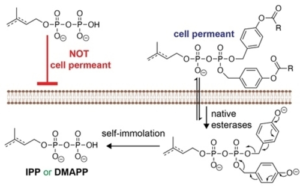Membrane Permeant Pyrophosphate Probes-
Terpenes are a class of natural products ranging from cholesterol and the steroid hormones, to vitamins A, D, E and K, and co-enzyme Q, to the compounds such as limonene, carvone, and menthone that give many flowers and fruit their pleasant scents. Over 80,000 terpenes have been structurally characterized, all of which are biosynthesized from the same two five-carbon precursors, dimethylallyl pyrophosphate (DMAPP) and isopentenyl pyrophosphate (IPP).

Both IPP and DMAPP are highly charged at neutral pH and thus cannot passively cross the cell membrane. Working with the Baccile Lab (SUNY Cortland ’11) at the University of Tennessee, Knoxville, we have developed a method that masks this charge, allowing the compounds to enter cells. Once inside cells, endogenous esterases act on the compounds to release the bioactive IPP and DMAPP. [link]

Current research in the lab centers on the use of our masked IPP and DMAPP derivatives to explore terpene biochemistry, the development of improved methods for the preparation of membrane permeant phosphates and pyrophosphates, and the development of new groups that will allow for the cellular release of IPP and DMAPP with spatial and temporal control.
Chemical Communication in Insect Larvae –
It is estimated that insect damage destroys a third of agriculturally important crops. In collaboration with Dr. Terrence Fitzgerald in the Department of Biology at SUNY Cortland, we have initiated a program to isolate and chemically identify the larval trail pheromone of the invasive insect Cactoblastis cactorum and explore the use of the pheromone as a species specific biological control of the insect.
As shown in the video below, we have demonstrated that Cactoblastis follow artificial trails prepared from hexane extracts of Cactoblastis larvae mandibular glands.
Undergraduate researchers in my lab have determined the chemical structures of the biologically active components of the hexane extract and have chemically synthesized theses compounds for further biological study.
Photoactive Compounds to study Cell Signaling –
The study of chemical communication at the cellular level can be facilitated by the use of reagents that inhibit or promote specific signal transduction pathways. By employing so called “caged” reagents, bioactive molecules that have been chemically modified with a photocleavable group that makes them biologically inert, biologists can administer such reagents at a precise time and location.
We have developed a new method for conjugating CPPs to bioactive peptides with copper catalyzed click chemistry and a photocleavable linker developed in our lab [link]. The photocleavable linker is traceless with respect to the bioactive peptide and easily prepared in two synthetic steps from commercially available starting materials.
